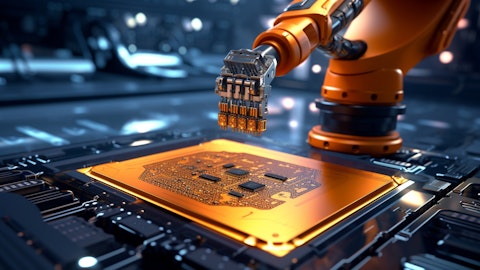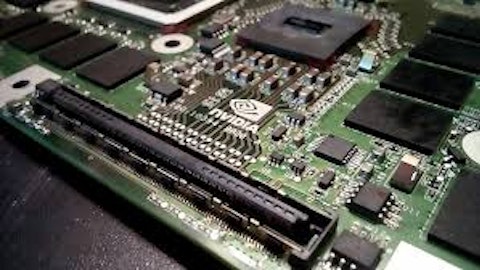And one of the reasons we have the AI Hub, because this is a new, I think, moment for the industry, it works a little bit different. It’s different than how you think about the traditional app store. You have many models, many in the open source models, they can run on the device and they can be attached or built into any application. So I think what’s starting to see is a lot of developer interest, as we said in the prepared remarks, we have over 100 different models, models from OpenAI to YAMA3 and many that are quantized and optimized to the NPU. When they are optimized using the tool, they run four times faster than the model without optimization. And those models and those use cases started to be implemented in apps, whether it is an image or associated with a camera, it’s associated with language.
So we’re at the beginning of that transition. We really like what we see because it’s really creating reason for people to buy a new device. It’s going to be the same on PCs, it’s going to be the same as they come to cars as well and in industrial. So it’s an exciting tailwind, I think, for our strategy of actually driving, computing, and connectivity at the edge.
Operator: Our next question is from the line of Timothy Arcuri with UBS.
Timothy Arcuri: Thanks a lot. I wanted to ask about the mix of the business and as you said, Akash, China is holding up quite well. It’s up 40% year-over-year in the fiscal first half, but it’s within shadowing distance of kind of where it peaked on a quarterly basis back in fiscal ‘22 when they were obviously overbuilding at that time. So can you talk a little bit about what’s happening there, how much of the year-over-year growth is units versus pricing?
Akash Palkhiwala : Yes, thanks, Tim. As we said earlier, it’s really the biggest benefit we are seeing is the mix being stronger. And as you know, competitive positioning is stronger at the higher tiers, and so that’s helping us. The second is when you look at generation over generation, the chips, especially at the premium tier are getting more capable as more not just GenAI, but other additional capabilities are being integrated into the chips and there’s strong competition between the OEMs, so there’s demand for those capabilities. So we’re seeing that come through as well, and it’s really a combination of those things that is driving strength versus a unit upside. The unit size we are seeing is very much aligned with the market forecast, which says flat market versus last year.
Timothy Arcuri: Got it. Okay. And then just as a quick follow-up. How sustainable are these RF wins that you’ve obviously gotten for this upcoming phone? Should we consider that as kind of part of the modem? So when the modem goes away, the RF wins also go away?
Akash Palkhiwala : So of course, we’ll not talk about any specific customer here. But I think I’d go back to the very first question that Cristiano answered. The key thing for us is the modem RF architecture and how when we develop the end-to-end together it creates an advantage for us in terms of performance, in terms of time to market for our customers as well and that’s a sustainable advantage that will stay going forward for us.
Operator: Our next question is from the line of Tal Liani from Bank of America.
Tal Liani: Hi, guys. When I look at your numbers, you bid the numbers mainly on headsets. It’s both for QTL and QCT, of course, and I’m trying to understand how much of the odd performance is just China versus the rest of the world? So when you look at the rest of the world, what were the trends? When it comes to your QCT shipments and QTL and then within China where are we in the recovery cycle, right? There is ongoing growth but there is what we’re seeing now in the first half of the year is mainly recovery from last year. So are you now at normal levels and from here it should trend? Normally based on demand or are we still recovering from the low of last year? Thanks.
Akash Palkhiwala : Yes, so a couple comments. First is on the overall picture across OEM. So China saw a very significant benefit, but we had strength across other parts of the Android ecosystem as well. And so it’s not something that was isolated to one or two OEMs. It was a broad trend that is just representative of the overall market and the mix shift that we discussed in the overall market. On your second question, as we think about our strength in handsets, we are very optimistic that as we go forward, this is a trend that holds forward. This is not about inventory. As I said earlier, the units are actually aligned with the size of the market and the trends are really driven by mix and increased content.
Tal Liani: Okay. Second question, just on the AI, I don’t know if it’s possible to quantify at all, but if you look at the non-AI QCT contribution versus an AI QCT contribution, when AI is included in the mix, is there a number where it comes to the increase in content per phone? Does it mean that the semiconductor there is going to be more expensive, higher price for you? So even if the market doesn’t grow, can you grow just by the market shifting to AI? That’s theoretical, but I’m trying to isolate the impact of AI. Thanks.
Cristiano Amon: A lot of people are talk, but let me try to give you maybe an answer to help explain this. In first step, a lot of the increased content in ASP on QCT chipsets, including premium, has been driven by the compute part and it’s more performance on the compute, CPU, GPU, the NPU. Second, the NPU, it has been the largest area of silicon growth in those chips, so generation over generation, and one of the largest improvements has been the NPU for AI, and AI is driving a lot of silicon content in those devices because they expected computational capability to run those models. The benefit financially, I think it’s going to come probably in the way that you’re starting to see the beginning of it right now, which improves the mix.
Users want to buy a more capable phone that can run AI, so it drives the market towards a richer mix of higher improvement here, share gains, and then an upgrade cycle as people want to buy a new phone. That’s how we should think about it in phones. PC is a little different. As we enter the PC, I think the AI and the ability to run on-device AI better than any of our peers on a laptop, I think it’s going to be a tailwind to the capability. Car, it builds more value on top of the platforms that are being commercialized and design win with the increase of the pipeline, especially in many of those platforms we can do a softer upgrade to be able to run GenAI on those vehicles, so I think that’s how this is going to materialize for Qualcomm. The last part of my answer is industrial which is a new area that we’re trying to upgrade to higher performance from microcontrollers to higher performance computing connectivity.





